Innovation is the process of devising solutions that address unmet customer needs. An innovation strategy is the systematic identification of unmet customer needs in a given market—and the selection of which unmet needs to target for growth.
Identifying and prioritizing unmet customer needs allows the business to grow market share or profits through reliably successful product and service innovation. It also makes it easy to develop a practical business model innovation.
Jobs-to-be-Done offers the perfect lens to view innovation strategy because it allows you to uncover all of your customers’ unmet needs.
An innovation strategy that systematically identifies and prioritizes unmet customer needs answers three critical questions to drive efficient business growth.
1. What is the most efficient path to growth?
An effective innovation strategy lays out the most efficient growth path. It helps a product team prioritize unmet needs that, when addressed, will have the greatest impact on the largest customer population.
Highly underserved needs across 100% of the customer population are prioritized ahead of outcomes that are moderately underserved across 50% of the population. This is one of the common innovation strategy examples around.
This prioritization method helps product teams accelerate their value-creation efforts and stay out of competitors.
2. Are you creating a single, platform-level product or a product portfolio?
The innovation strategy also informs whether a product team creates a single, platform-level product versus a product portfolio (several products targeted at different segments).
If you're creating a single, platform-level product, you are optimizing the product to address the top unmet needs of a single customer segment. When your objective is a product portfolio, you target specific offerings at different segments. Each product is optimized to address the top unmet outcomes in each segment.
3. What kind of innovation strategy should you pursue?
After completing the first steps of an effective innovation strategy, product teams know — with high certainty — whether the remainder of your innovation efforts should pursue disruptive, dominant, discrete, or sustaining innovation strategies.
Knowing where to focus on creating value and which strategy to use puts product teams on the fast path to achieving product-market fit — with better products that get the job done.
People buy products and services to get a job done. The first step to building a successful innovation strategy is defining your market around this job-to-be-done.
Unlike products and technologies that will one day be obsolete, the job provides your company with a stable focal point around which to align create value.
Using this lens, your market should be defined as follows:
A Market = A Group of People + The Job They’re Trying to Get Done
Learn More: Define Your Market
The second step of developing an innovation strategy you can count on is extracting the needs of the market.
Customers want to get their jobs done perfectly. We have discovered that customers consider between 50 and 150 metrics when assessing how well a product or service helps them to complete a given job. These metrics (or desired outcomes) are the customers’ needs — and the power behind this innovation process. They define what perfection means and instruct your company on how to deliver value.
You uncover these needs by conducting a series of highly-structured customer interviews, and you organize them by creating a job map.
It takes qualitative, quantitative, and analytical methods to provide the insights we need to formulate a robust and reliable innovation strategy — starting with quantifying each customer outcome.
Customers have underserved and overserved outcomes. Knowing with statistical certainty which outcomes should be the focus of value creation and cost reduction ensures efficient deployment of resources and greatly improves your odds of success in the market.
This step requires surveying customers on:
Most people segment their markets demographic, psychographic, behavioral, and/or attitudinal market segmentation schemes that squarely target their products and services at phantom targets—segment classifications that are imposed on customers but, in reality, do not exist.
Instead, the best way to segment customers is around unmet needs.
Different groups of people struggle differently when executing the job-to-be-done. Most markets also have one or more segments that are underserved, as well as segments that are overserved.
Knowing the size of each segment, what outcomes are unmet in each segment, and how much those in each segment are willing to pay to get the job done better is the secret to formulating an effective innovation strategy.
Learn More: Market Segmentation
The insights that come out of the first four steps of this process are illuminating. Most companies have never had customer insights like this before, nor the decision-making advantages that come along with them.
Using the insights from this innovation process, you can determine which strategy is best, allowing you to make the winning move.
Dive Deeper: Outcome-Driven Innovation
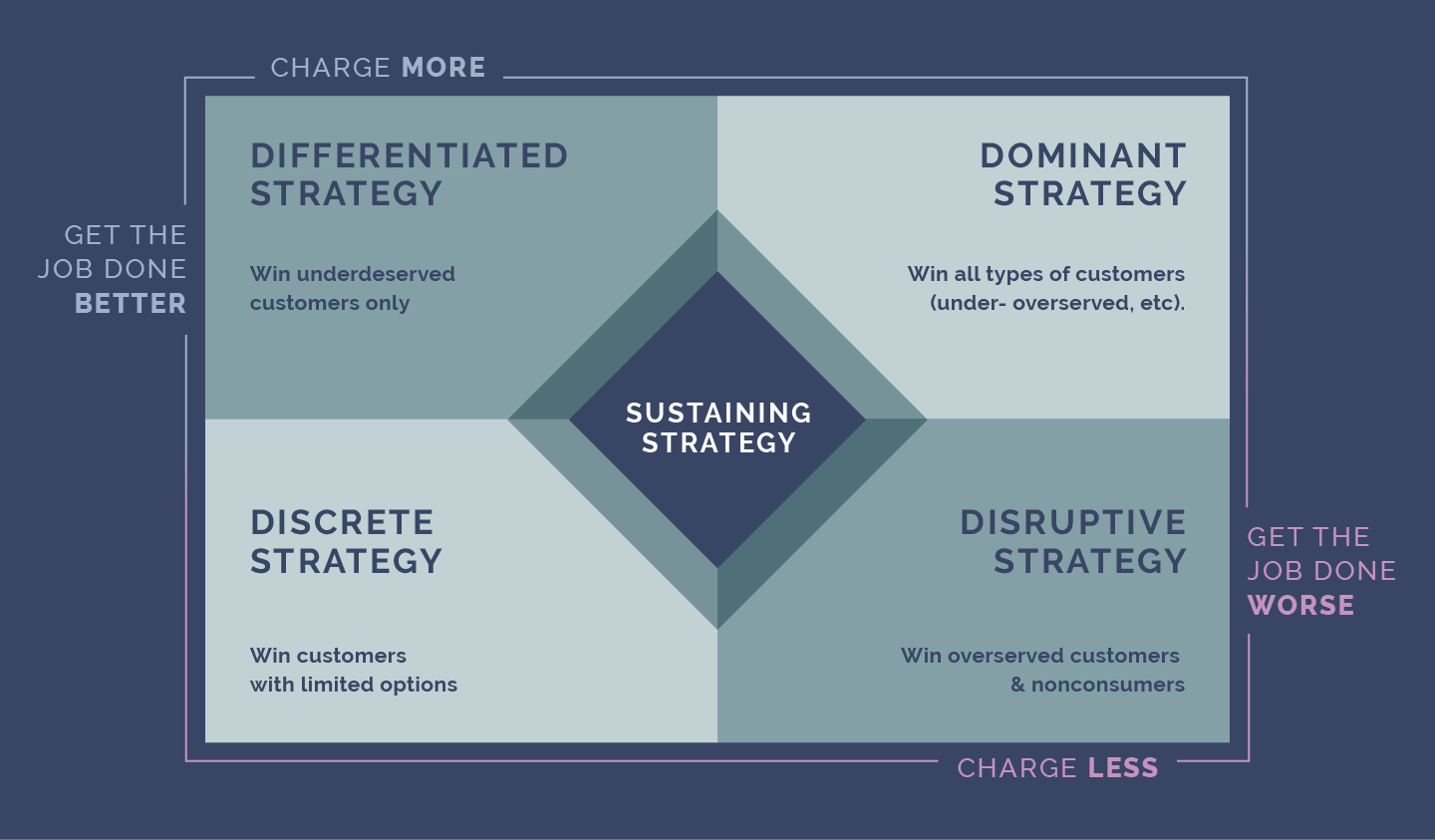
You’ve probably heard of four types of traditional innovation strategies:
The problem with these strategies is they don't tell you how to deliver value to your customers. To do understand how to deliver value we need to look at at innovation through the lens of Jobs-to-be-Done. Your options include:
Once you’ve completed the first four steps of building your innovation strategy, it will be clear which type of these strategies your product teams should pursue.
A differentiated innovation strategy helps customers to get their job done better — but for a higher cost.
You’ll want to pursue a differentiated strategy when you discover a population of underserved consumers that you want to target with a new product or service offering that gets their job (or multiple jobs) done significantly better, but at a significantly higher price.
Examples of differentiated products include:
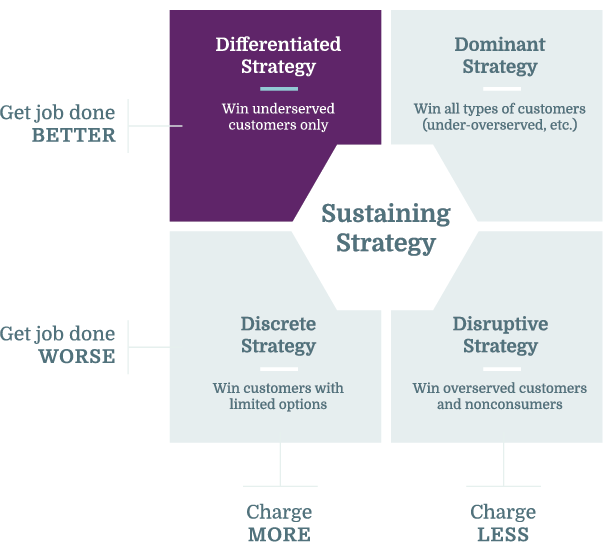
A dominant innovation strategy targets all consumers in a market with a new product or service offering that gets a job done significantly better and for significantly less money. A better-performing, less expensive product appeals to everybody.
Examples of offerings that successfully employed a dominant strategy include:
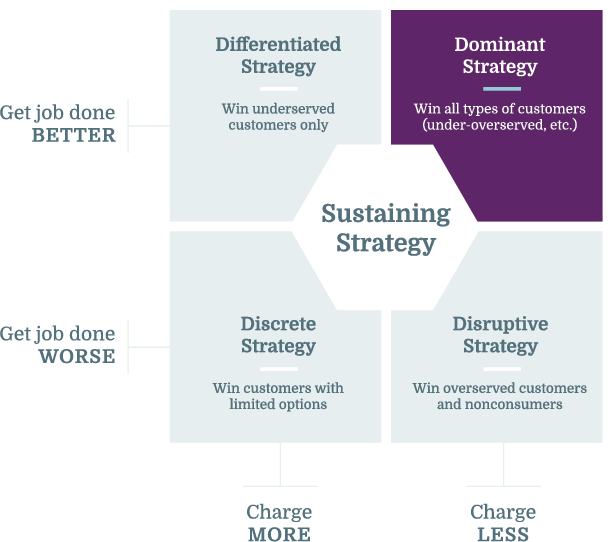
You’re pursuing a disruptive strategy when you discover and target a population of over-served customers or non-consumers with a new product or service offering that helps them to get a job done more cheaply—but not as well as competing solutions.
Examples of disruptive products:
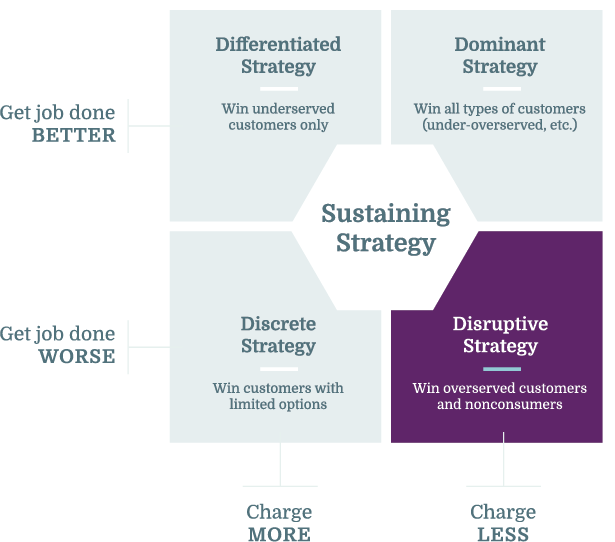
A discrete innovation strategy targets a population of “restricted” customers with a product that gets the job done worse, yet costs more. A worse-performing, more expensive product will only appeal to customers for whom limited (or no) alternatives are available.
This strategy can work in unique or atypical situations, where customers are legally, physically, emotionally, or otherwise restricted in how they can get a job done.
Examples:
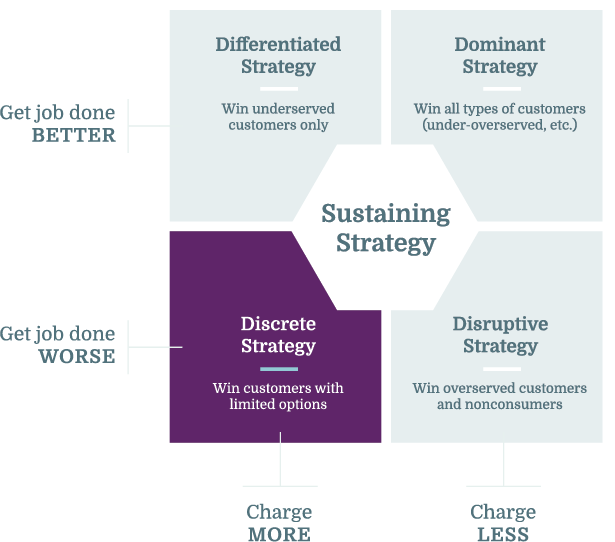
Sustaining innovation strategies introduce a new product or service offering that gets the job done only slightly better and/or slightly cheaper. This kind of product probably won’t attract any new customers. It’s a poor strategy for a new market entrant, but it may help an incumbent company retain existing customers.
Examples of offerings that successfully employ a sustaining strategy are plentiful.
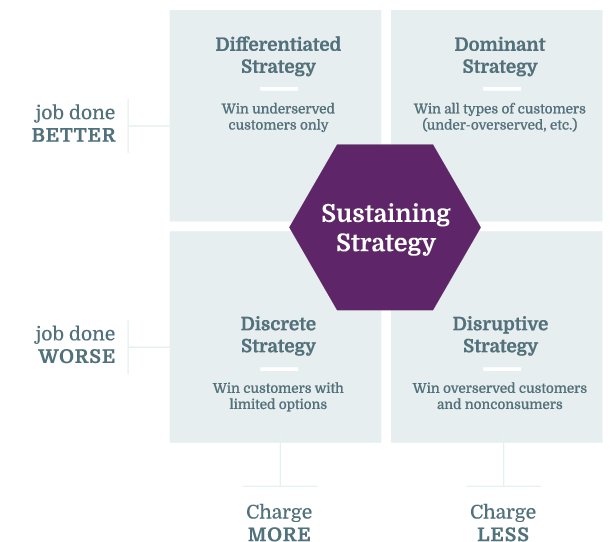
An effective innovation strategy comes with many benefits, most of which center around getting your various teams on the same page to create value.
There is a clear link between innovation and value—for customers and for the business. In fact, historical data from BCG shows the correlation between value and innovation has grown even stronger over the last two decades.
All of the following benefits help a business achieve long-term success.
Misalignment is inherent in the design of product teams. Companies are organized into functions, each optimized to serve their particular purpose. Sales, marketing, product development, R&D—all have different goals, rely on different inputs to achieve those goals, and each has its own language for communicating how to create customer value.
When teams can’t agree on what actions will create value for the customer, it’s challenging at best to agree on a common path forward.
The solution to misalignment among organizational silos is to define value creation through the eyes of the customer and establish a shared understanding of customer needs across functions. When teams agree on the definition of a customer need, what their customers’ needs are, and which of these needs are unmet, it’s transformational for the organization.
Dive Deeper: Align Your Product Teams Around Value Creation
Are your customers cobbling together solutions to get the full job done? Typically, the answer is ‘yes.’ And yet, it’s the most complete products and services that help the customer get more of the job done that will win in the market.
An innovation strategy that outlines and prioritizes all of your customers’ needs makes it easy for you to see where the holes are in your portfolio—and work on filling them. This may mean creating new products on your own, or you may pursue a partnership, merger, or acquisition to quickly fill the gaps.
Cox Automotive, for example, used insights from their innovation strategy to continually inform M&A activity years after the initial research was complete.
Without a feature prioritization method anchored around a well-defined set of customer needs, you often end up with feature creep—more and different features than what you originally planned.
Then it’s not surprising when the product is late to market, costs more than planned, or incorporates features that your customers don’t really care about.
Once your teams are aligned around a shared understanding of customer needs, defining a clear product roadmap is easy.
Using ODI for product feature prioritization unifies the team around a single version of the truth. You have confidence that you’re solving the right problems, everyone is working toward solving the same specific set of problems, and everyone knows their role in the process. No one is distracted by side projects or arguing for a different set of features—because they’ve all bought into your quantified priorities.
Learn More: Product Feature Prioritization—How to Align on the Right List
Innovation doesn’t always have to be around the product itself—you can also innovate how you communicate about this product to the market.
An innovation strategy built on Jobs-to-be-Done allows you to create enviable positioning and messaging by:
For example, Arm & Hammer Animal Nutrition saw immediate growth by focusing on the correct job executor and adjusting the messaging to match. Within a year, this new messaging strategy helped their customers see value in their products and services, resulting in a 30% increase in revenue.
Microsoft also doubled year-over-year revenue after repackaging existing solutions into a more cohesive offering that helped customers complete more of their job-to-be-done.
Learn More: How Marketing Teams Align Around Enviable Messaging
Today, many companies find themselves threatened by digital disruptors that are innovating around the broader customer experience. But focusing on the underlying reason your customer uses your product—rather than the product itself—allows you to build a disruption-proof advantage.
When you rally resources around getting the job done better, you look at all possible solutions as a natural part of your portfolio. Over the long term, you are continuously focused on completing more and more of the customer’s job. This helps you see and react to a broader competitive landscape, reducing the prospect of being blind-sided by a disruptive solution.
On the other hand, a company focused on technology is more likely to miss opportunities and face disruption.
Dive Deeper: Your Market is Bigger Than Your Product
When it comes to innovation strategy examples, you often hear about the likes of Apple, Amazon, Google, and Starbucks. But what about some lesser known innovation projects that are just as impressive — and easier to replicate?
In the early 2000s, Kroll Ontrack had an exciting technology that would allow them to digitize legal document discovery for the first time. But they had failed on their first two attempts at market entry.
So they switched gears and applied our five-step innovation strategy to the challenge to understand what was going wrong.
It turns out, they were focused on the wrong customer — the wrong job executor. Kroll was trying to sell their solution to IT, and they positioned the technology as a solution that would allow them to efficiently retrieve data off a hard drive.
But it’s the legal team that needs the document discovery tools, and the legal team isn’t trying to retrieve data from a hard drive. They’re trying to find information to support or refute a case. And these lawyers had several important unmet needs.
With this insight, Kroll made some critical adjustments:
On their third launch attempt, they made it big.
Kroll’s electronic document discovery product went from $0 to $200 million in ~3 years, and they were the market leaders in the space for about 12 years.
Check out the full Kroll Ontrack case study.
Cox Automotive’s vAuto division offers auto dealers SaaS solutions to better manage their inventory. They had been highly successful, but they were no longer seeing the gains they needed to continue to grow market share.
The team had already discovered the most obvious opportunities for product innovation — now they needed to find the not-so-obvious opportunities to keep ahead of their competitors.
Randy Kobat, SVP at Cox Automotive, explained: “We would spend time launching new features in the software, and they just weren’t adopted. And they didn’t make a measurable improvement in the performance of the business.”
How could they know for sure which capabilities would really matter to their customers?
They stopped guessing at the right innovations. Instead, they used the five-step innovation strategy to uncover exactly what their customers wanted in a solution.
A few of the needs that rose to the top of the list:
These customer needs served as perfect instructions for Cox Automotive’s product team—and they were able to quickly launch new features to meet them, resulting in a 20X increase in product installs.
The insights even ended up informing M&A activity.
Get all the details in the full Cox Automotive case study.
How would you like to achieve double-digit revenue growth — without making a single change to your product or pricing? Arm & Hammer’s animal nutrition division used this innovation strategy to make it happen.
The company believed their customer was the animal herd nutritionist. They sold to this customer, got inputs from this customer, and optimized their products and messaging for this customer.
They were selling premium products that did, in fact, deliver on the animals’ nutritional needs.
The problem was that they were defining their market around their nutritional products and making assumptions about who their true customer was. Like Kroll Ontrack, they were focused on the wrong job and job executor.
It wasn’t the nutritionist they should be focused on — it was the herd producer. The producer is the customer using the nutritional product to get a job done, and the producer’s job is to increase herd productivity — not improve nutrition.
They set to work getting to know this customer, uncovering their needs, and determining which needs were unmet. With this insight, Arm & Hammer adjusted their messaging and armed their sales team with that new messaging.
They connected what they do more closely with what their true customer wanted to accomplish — and without any changes to their product or pricing, they achieved 30% YoY growth.
Learn more in the full Arm & Hammer case study.
To effectively measure the success of an innovation strategy, specific metrics must be tied directly to the customer’s job-to-be-done and desired outcomes. Desired outcome statements are critical as they define how customers measure success.
These metrics should be clear, measurable, and stable over time, allowing companies to track progress and effectiveness consistently. Metrics such as the importance and satisfaction of desired outcomes and the extent to which a new solution helps customers get a job done better and/or more cheaply are essential.
For example, the Opportunity Algorithm uses these metrics to calculate opportunity scores, highlighting which outcomes represent the best growth opportunities.
Maintaining flexibility in an innovation strategy to adapt to unforeseen market changes involves incorporating iterative processes and feedback loops into the strategy. The Outcome-Driven Innovation (ODI) process emphasizes continuous customer engagement to understand their evolving needs and adapt solutions accordingly.
By regularly revisiting and updating the job maps and desired outcome statements based on new customer insights and market conditions, companies can stay aligned with customer expectations and swiftly pivot their strategies. Additionally, employing both qualitative and quantitative research methods allows organizations to identify and respond to shifts in customer priorities and market dynamics in a timely manner.
Cultural factors within an organization play a crucial role in the success of implementing an innovation strategy. A supportive culture that encourages cross-functional collaboration, openness to change, and a shared understanding of customer needs is vital. Tony Ulwick stresses the importance of creating a common language of innovation and ensuring that all departments are aligned with the customer’s job-to-be-done.
This alignment helps mitigate resistance to change and fosters a unified approach to innovation. Leaders should promote a culture of continuous learning and adaptability, where feedback is valued and integrated into the innovation process. By doing so, organizations can cultivate an environment conducive to successful innovation strategy implementation.
Balancing short-term operational goals with long-term innovation initiatives within an innovation strategy requires a careful and integrated approach. The Outcome-Driven Innovation (ODI) process is designed to align with both immediate and future objectives by focusing on customer needs and desired outcomes.
This alignment helps ensure that the innovation strategy is both responsive to current market demands and adaptable to future opportunities.
Firstly, it is crucial to establish a clear understanding of the customer’s job-to-be-done and desired outcomes. By focusing on these stable and long-term needs, organizations can ensure that their innovation efforts are always aligned with what will ultimately drive customer satisfaction and business success. This customer-centric approach ensures that even short-term projects contribute to long-term strategic goals.

If you’re ready to launch the next big thing, it’s time to upgrade your ideation process to Outcome-Driven Innovation. Get in touch to speak with one of our innovation experts.
If you’re ready to launch the next big thing, it’s time to upgrade your ideation process to Outcome-Driven Innovation. Get in touch to speak with one of our innovation experts.
Copyright ©2024 Strategyn LLC. All Rights Reserved. | XML Sitemap | HTML Sitemap